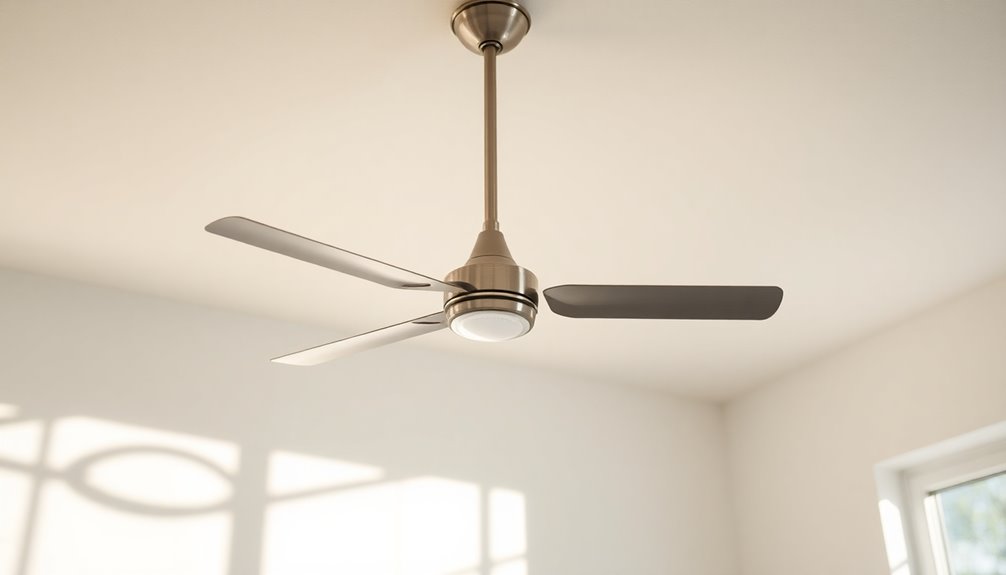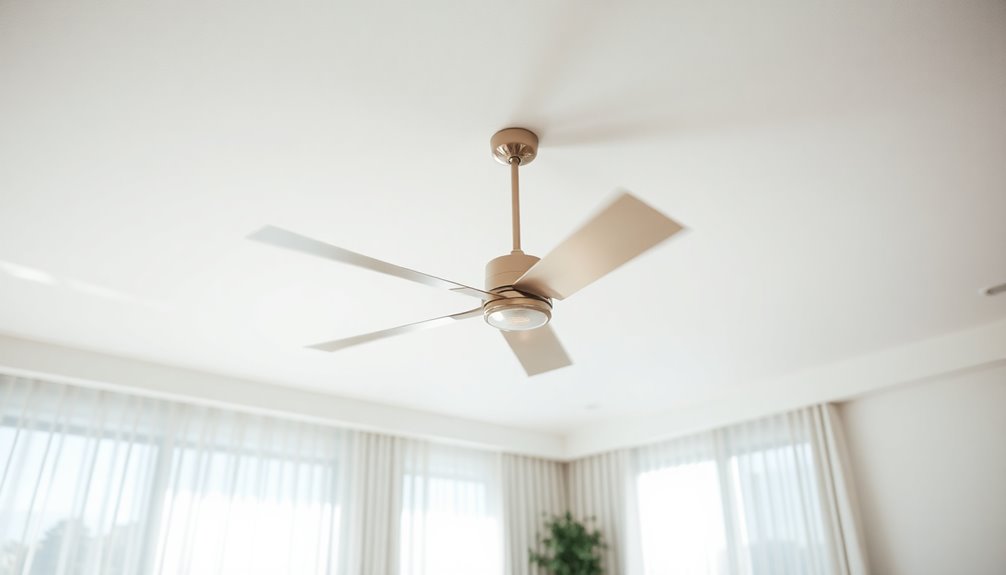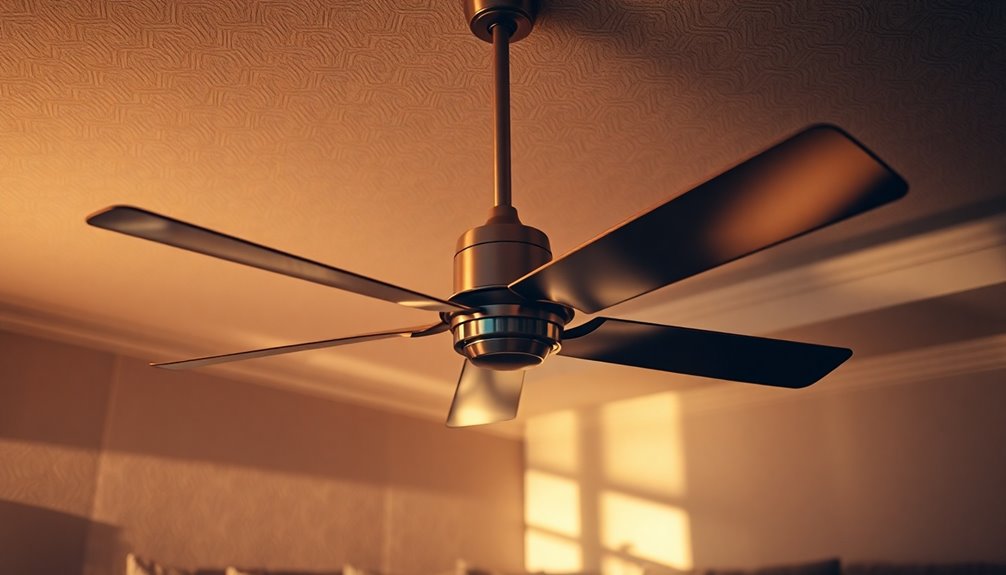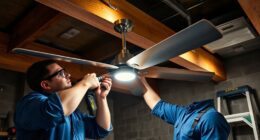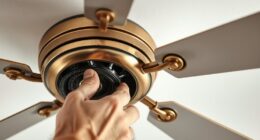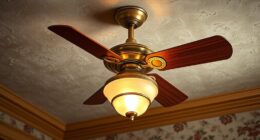To keep your space cool in summer, your ceiling fan should rotate counterclockwise. This direction creates a downdraft, enhancing the wind chill effect and making you feel cooler without actually lowering the room temperature. You'll want to verify the fan is set to high speed for maximum airflow. Standing beneath the fan can help you confirm that the air is being pushed down. Always double-check the rotation direction with the changing seasons to guarantee peak performance. Interested in learning more about ceiling fan tips and energy savings? There's plenty more to discover about efficient fan usage!
Key Takeaways
- Ceiling fans should rotate counterclockwise in summer to create a downdraft that cools the room effectively.
- The counterclockwise rotation enhances the wind chill effect, making occupants feel cooler without lowering air temperature.
- Ensure the fan blades have a minimum angle of 12 degrees for optimal airflow during the summer.
- Adjust the fan direction at the start of summer, ideally during Daylight Savings Time for best efficiency.
- Always check airflow by standing beneath the fan to confirm it is directed downward for cooling.
Ceiling Fan Direction Basics

When it comes to ceiling fan direction, understanding the basics can make a significant difference in your comfort during the summer months.
To keep your space feeling cool, you should make sure your ceiling fan turns counterclockwise. This direction creates a downdraft that pushes cool air downward, enhancing the overall airflow in your room. As the fan rotates counterclockwise, you'll experience the wind chill effect, which tricks your body into feeling cooler, even though the air temperature remains the same.
Running your ceiling fan at high speed during the summer not only boosts comfort but also allows you to raise your thermostat setting by about 4 degrees. This adjustment can lead to energy cost reductions of up to 30%, as you'll rely less on your air conditioning system.
To confirm your ceiling fan is rotating correctly, stand underneath it and feel the airflow directed toward you. If the air is moving down, you've got it right.
Benefits of Summer Rotation

When you set your ceiling fan to rotate counterclockwise in the summer, you create an invigorating airflow that enhances your comfort.
This simple adjustment not only makes you feel cooler but can also lead to significant energy cost savings.
Cooling Airflow Effect
The invigorating effect of a properly adjusted ceiling fan during summer can make a significant difference in your comfort level. When you set your ceiling fan switch to rotate counterclockwise, it creates a revitalizing downdraft that pushes cool air downward. This airflow generates a wind chill effect, allowing you to feel cooler without actually lowering the room temperature.
By using your ceiling fan in this way, you can comfortably raise your thermostat setting by about 4 degrees. This adjustment not only enhances your comfort but also helps in reducing air conditioning costs. A well-optimized ceiling fan can work wonders in conjunction with your cooling and heating systems, making your space more enjoyable.
To maximize the cooling airflow effect, verify that the fan blades have a minimum angle of 12 degrees. This angle optimizes airflow, increasing the overall cooling efficiency during those hot summer months.
Energy Cost Savings
Energy savings become a tangible benefit when you adjust your ceiling fan for summer use. By setting your fan direction in summer to counterclockwise, you create a cool breeze that enhances your comfort without dropping the room temperature.
This simple change can allow you to raise your thermostat by about 4 degrees Fahrenheit while still feeling comfortable. As a result, you could see energy cost savings of up to 30% on your cooling bills.
Ceiling fans are remarkably efficient, consuming only about 50 watts of energy, compared to air conditioning units that average 3,500 watts. This significant difference makes ceiling fans a cost-effective cooling solution.
When you pair your ceiling fan with an ENERGY STAR-rated air conditioning unit, you can achieve an additional 8% reduction in energy consumption, further maximizing your savings.
To truly benefit from this energy cost savings, it's essential to change your ceiling fan's rotation for summer. This not only improves air circulation but also reduces your reliance on air conditioning, ultimately lowering your utility bills.
Enhanced Comfort Levels
Adjusting your ceiling fan to rotate counterclockwise in summer greatly enhances your comfort levels. This direction creates a downdraft that pushes cool air down, making your space feel more comfortable.
You'll notice the difference as the wind chill effect can lower perceived temperatures, allowing you to raise your thermostat by about 4 degrees without sacrificing comfort.
Running your ceiling fan at high speed not only maximizes airflow but also complements your air conditioning system, enhancing its efficiency. This means you can enjoy a consistent room temperature throughout the day, minimizing hot spots and ensuring you're comfortable no matter where you're in the room.
Moreover, with the right ceiling fan direction, you can considerably reduce air conditioning costs by up to 30%.
Switching your fan to counterclockwise is a simple yet effective way to create enhanced comfort and save money during the hot summer months. So, take a moment to adjust your fan, and enjoy the cool air while keeping your energy bills in check.
How to Change Direction

Before you change your ceiling fan's direction, make sure to turn it off for safety.
If you have a pull chain fan, simply locate the reversing switch and adjust it for summer use.
For remote-controlled fans, hold the button on your remote until the light blinks before turning the fan back on.
Safety Precautions First
Changing the direction of your ceiling fan is essential for maximizing comfort, but safety should always come first. Before you start the process to change the direction, verify you take the right precautions to avoid accidents.
Here are some safety tips to follow:
- Turn Off the Fan: Always switch off your ceiling fan before attempting any changes. This helps prevent any unexpected injuries.
- Check the Type of Fan: Identify whether your fan uses a pull chain, remote, or smart controls before proceeding to change the direction.
- Use Proper Tools: If your fan requires tools for adjustment, make sure you have them handy. This can save you from unnecessary trips to find what you need.
- Wait for the Fan to Stop: Allow the blades to come to a complete stop before reaching for the reversing switch or remote control. This ensures your hands are safe from moving parts.
Manual Direction Change
Now that you've confirmed safety measures are in place, you're ready to adjust your ceiling fan for summer comfort.
To change the direction of your ceiling fan, first make sure it's turned off. If you have a pull chain fan, locate the reversing switch on the fan body. Slide it to the counterclockwise position, then turn the fan back on. This will allow your fan to spin counterclockwise, creating a cool breeze that enhances your summer comfort.
For remote-controlled fans, start by turning off the fan. Press and hold the fan button on the remote until the light blinks, then turn the fan back on. This process sets the fan to spin counterclockwise as well.
If your fan is a smart model, you can use the SIMPLEconnect app or issue a voice command to change the direction, but remember to power off the fan first.
Regularly check the fan direction, especially as seasons change, to verify you're maximizing cooling effectiveness. In summer, you want your ceiling fan to spin counterclockwise; this is key to keeping your space cool and comfortable.
Remote Control Adjustment
To adjust your remote-controlled ceiling fan for summer, start by ensuring the fan is turned off to prioritize safety.
Once you've done that, you can make the necessary adjustments to change the ceiling fan's direction for ideal cooling. Here's how:
- Locate the Reverse Button: Find the reverse button on your remote control. It's usually marked with a directional arrow or symbol.
- Press and Hold: Press and hold the reverse button until the fan light blinks. This blinking indicates that the direction has been successfully changed.
- Turn the Fan On: After the light blinks, turn the fan back on. Make sure it's rotating counterclockwise to achieve that summer cooling effect.
- Use a Mobile App (if applicable): If you have a smart ceiling fan, you can also use a mobile app to change the direction, but remember to power off the fan before making this change.
Optimal Settings for Summer

When summer hits and temperatures rise, adjusting your ceiling fan settings is key to staying comfortable. To maximize your comfort, verify your ceiling fans rotate counterclockwise. This direction creates a downdraft that pushes cool air downward, helping you feel cooler without actually lowering the room temperature. Running your fan at high speed enhances this effect, allowing you to raise your thermostat setting by about 4 degrees while still feeling comfortable.
Proper airflow can also reduce your air conditioning costs by up to 30%, as it minimizes the need for constant cooling. To check if your fan is set correctly, stand directly beneath it; if you feel a strong breeze, it's rotating counterclockwise.
Here's a quick reference table for ideal summer settings:
| Ceiling Fan Setting | Effect |
|---|---|
| Direction | Counterclockwise |
| Speed | High speed |
| Airflow | Creates downdraft |
| Temperature Raise | Up to 4 degrees |
| AC Cost Reduction | Up to 30% |
Ceiling Fan vs. Air Conditioning

Here are some key points to take into account:
- Energy Consumption: Ceiling fans use about 50 watts, while air conditioning units consume around 3,500 watts. This makes ceiling fans a much more energy-efficient choice. Additionally, the energy savings from using ceiling fans can be similar to those offered by geothermal heat pumps. Modern heat pumps can effectively reduce energy costs while providing comfortable temperatures. Moreover, utilizing gold IRAs can enhance your long-term investment strategy by diversifying your portfolio.
- Cooling Effect: Ceiling fans create a wind chill effect, helping you feel cooler without actually lowering the room temperature. This can reduce your dependency on air conditioning. Additionally, using ceiling fans can help improve ventilation and air quality in your home.
- Cost Savings: By pairing ceiling fans with air conditioning, you can raise your thermostat settings by about 4 degrees, maintaining comfort while cutting cooling costs.
- Energy Star Efficiency: Using ceiling fans with ENERGY STAR-rated air conditioning can lead to additional savings of up to 8%.
In essence, ceiling fans and air conditioning each have their advantages, and energy-efficient technology can further enhance your overall cooling strategy.
Energy Savings With Fans

Maximizing energy savings with ceiling fans is easier than you might think. By setting your ceiling fan to rotate counterclockwise during the summer, you create a downdraft that pushes cooler air downwards, enhancing your comfort.
This simple adjustment not only makes your space feel cooler but also allows you to raise your thermostat setting without sacrificing comfort.
When you use ceiling fans alongside your air conditioning, you can achieve energy savings of up to 30%. Since a ceiling fan operates on about 50 watts of power, compared to the 3,500 watts used by typical air conditioning units, it's a cost-effective way to keep your home comfortable.
A well-functioning ceiling fan helps maintain a consistent room temperature, reducing the need for constant air conditioning operation and lowering your energy bills.
Common Misconceptions

While ceiling fans can greatly enhance your comfort and energy savings, there are several misconceptions that can lead to ineffective use. Understanding these common misconceptions is essential for maximizing your fan's potential:
- Ceiling fans cool the air: This is false. Fans create a wind chill effect, making you feel cooler but not lowering the room temperature.
- Fans can cool an entire room: Many people believe this, but fans only cool people by enhancing evaporation on the skin, not the air itself.
- Fan blade direction doesn't matter: It actually does! Turning the fan counterclockwise in summer can save you up to 30% on energy costs by allowing you to raise your thermostat comfortably. This can be especially beneficial when used alongside high-performance units that provide efficient cooling and help ensure better air quality throughout your home. Additionally, using fans in conjunction with a home security system can enhance overall comfort and safety.
- All ceiling fans are the same: This couldn't be further from the truth. Different designs and blade angles can greatly affect how effectively a fan circulates air.
- Proper air circulation is crucial for maintaining comfort and can be enhanced by using ceiling fans in conjunction with HVAC systems.
Seasonal Maintenance Tips

To keep your ceiling fan running efficiently during the summer months, it's vital to perform some seasonal maintenance. Start by making sure your ceiling fan turns counterclockwise. This direction creates a downdraft, pushing cooler air down and making your home feel more comfortable. Adjust your fan at the beginning of summer, ideally during Daylight Savings Time, to maximize airflow.
Next, check the fan's height. It should be at least 7-9 feet from the floor to guarantee effective airflow. Clear any obstructions from the ceiling and walls to allow for better circulation.
Regularly cleaning the blades is essential, as dust buildup can hinder performance. A clean fan operates more efficiently, providing cooler air.
When you're ready to run your fan, consider using a medium or low speed. Operating at high speed can help you raise your thermostat setting by about 4 degrees, allowing for energy savings of up to 30%.
These simple maintenance tips will help your ceiling fan provide the cooling relief you need all summer long.
Understanding Fan Blade Angles

Understanding the angle of your ceiling fan blades can greatly impact its cooling efficiency during summer. An ideal blade angle helps create a powerful downdraft effect, pushing cool air downwards and improving your overall comfort.
Here are some key points to take into account:
- Minimum Blade Angle: Aim for a minimum blade angle of 12 degrees for effective cooling efficiency.
- Ideal Air Circulation: Blade angles above 16 degrees can enhance air circulation but may also disturb loose objects in the room.
- Room Size Matters: For larger spaces over 500 square feet, using multiple fans guarantees adequate airflow and cooling.
- Adjusting Angles: Regularly adjusting the blade angle can maximize your fan's cooling potential, leading to lower energy costs.
Frequently Asked Questions
How Do You Tell if a Fan Is Going Clockwise or Counterclockwise?
To tell if a fan's going clockwise or counterclockwise, stand directly beneath it and observe the airflow.
If you feel air being pushed down towards you, it's spinning counterclockwise. You can also check the pull chain or switch; cooling modes typically mean counterclockwise rotation.
If you're unsure, look for a reversing switch on the motor housing. Flip it while the fan's off to change the direction and confirm its movement.
Why Does the Ceiling Fan Rotate in a Clockwise Direction?
You might think a ceiling fan spins clockwise just to mess with your head, but it actually serves a purpose!
When it rotates in that direction during winter, it creates a gentle updraft, pushing warm air down where you can actually feel it.
This means you stay cozy while saving on heating bills.
Do Ceiling Fans Cool a Hot Room?
Ceiling fans don't actually cool a hot room; they create a wind chill effect that makes you feel cooler.
When you run your fan, it helps evaporate moisture from your skin, enhancing comfort.
You can raise your thermostat by about 4 degrees and still feel comfortable, saving energy.
How to Tell Fan Direction?
To determine your fan's direction, stand beneath it and feel the flow. If you sense a soothing breeze, it's spinning counterclockwise. If you notice a stillness, it's likely clockwise.
Always check for a switch on the fan; it's typically found on the motor housing. For safety, switch off the fan before adjusting.
You might also spot an arrow indicating the intended spin, helping you confirm it's set for ideal airflow.
Conclusion
In summer, your ceiling fan should spin counterclockwise to create a cool breeze that makes you feel comfortable without cranking up the AC. Isn't it amazing how a simple adjustment can enhance your space? By optimizing your fan's direction and settings, you can enjoy a revitalizing airflow while saving energy. Don't forget to maintain your fan for peak performance. So, are you ready to beat the heat with just a flick of a switch?
